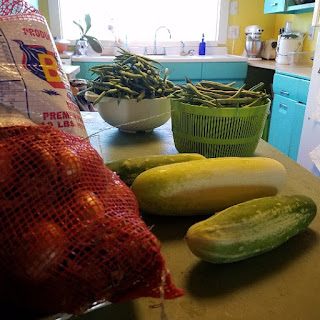Look at all those pears! The old pear tree in the front yard is loaded this year. The pears are still small, but the branches are drooping from the weight of them.
The branches make nice shade for some evening green bean breaking. I still have bags of beans in the refrigerator, and it's time to pick more! The small beans don't have strings, so I could just break them in pieces. The larger beans have strings, but they have nice big beans in them.
I spread the beans on cookie sheets and froze them, then dumped all the frozen beans in a big bag and put them in the freezer. I've been warned that freezing them may make them rubbery, so this will be a test batch. By freezing them on the cookie sheets before putting them in the bag, I should be able to just pour out the amount I need, because they won't be frozen into a lump.
Some wooden stakes with orange flags tied to them have shown up in the field on the other side of the neighbors driveway and pond. The stakes seem to be placed on the boundary between our good neighbors field and the adjoining property, which is a big field that occasionally gets mowed. I'm guessing that someone is marking the property line because that the field is being sold. Does this mean we may have a new neighbor? I'm trying to appreciate my unoccupied view as much as possible now, just in case it's about to change forever.
This landscape is always changing. The small trees around the neighbors pond are growing into big trees, and the water in the pond is barely visible in the summer now. The weedy fence line across the road is growing into a solid wall of small cedar trees, which will eventually change our view of the distant pastures and hay fields. Our own property boundaries are sprouting saplings, and changing what we see. The land here wants to be a forest. It takes constant work by humans to suppress the forest, and maintain the open agricultural landscape.
I think we will always have a big sky view.
The trees can't grow tall enough to block our view of the clouds.

































































